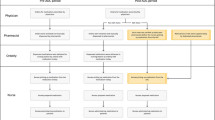Summary
Although tremendous advances have been made in the diagnosis and treatment of patients, hospital administrative systems have progressed relatively slowly. The types of information available to managers in industrial sectors are not available in the health sector. For this reason, many phenomena, such as the variations of average costs and lengths of stay between different hospitals, have remained poorly explained.
The DRG system defines groups of patients that consume relatively homogeneous quantities of hospital resources. On the basis, it is possible to standardize average lengths of stay and average hospital costs in terms of the differences in case mix treated. Thus DRGs can serve as an explanation of variations in these factors between different hospitals, and also (but not only) for prospective reimbursement schems. As in a number of other European countries, a project has been set up in Switzerland to examine the possibilities of using DRGs in hospital management, planning and financing.
Resumé
Alors que des progrès considérables ont été faits dans le diagnostic et le traitement des patients, les systèmes de gestion hospitaliers ont progressé beaucoup moins vite. Les types d'information habituellement utilisés dans le secteur industriel ne sont pas actuellement disponibles dans le secteur sanitaire. Pour cette raison, beaucoup d'observations restent mal expliquées: c'est le cas par exemple des variations des coûts par cas ou des durées de séjours entre les hôpitaux. Le systême des DRGs (Diagnosis Related Groups) définit des groupes de patients qui consomment des quantités relativement homogènes de ressources hospitalières. Sur cette base, il est possible de standardiser les coûts moyens et les durées moyennes de séjour par rapport aux différences de case mix. C'est ainsi que les DRGs peuvent intervenir directement dans l'analyse des variations entre hôpitaux; de même ils peuvent être utilisés comme base de remboursement prospectif des hôpitaux. Comme c'est le cas dans beaucoup d'autres pays européens, un projet a été élaboré en Suisse pour examiner les possibilités d'utilisation des DRGs pour la gestion, la planification et le financement des hôpitaux.
Zusammenfassung
Währeend in den letzten 20 Jahren enorme Fortschritte in der Diagnostik und Therapie erzielt wurden, blieb das Verwaltungssystem der Spitäler relativ unverändert. Die im Industriesektor für die Planung üblicherweise verwendeten Informationen fehlen im Bereich der Gesundheitsversorgung. Aus diesem Grunde kann man sich manche Beobachtung nicht erklären, so etwa die von Klinik zu Klinik verschiedenen Kosten per Krankheitsfall oder auch die Unterschiede in der mittleren Aufenthaltsdauer. Das DRG-Klassifikationssystem (Diagnosis Related Groups) definiert Patientengruppen mit relativ homogenem Pflegeaufwand. Auf dieser Basis wird es möglich, die Durchschnittskosten und die mittlere Aufenthaltsdauer nach der Patientenstruktur («Case Mix») zu standardisieren. So kann das DRG für einen Vergleich zwischen den Spitälern dienen. Gleichzeitig kann es auch als Grundlage für eine prospektive Finanzierung der Spitäler verwendet werden. Wie in vielen europäischen Ländern, so wurde auch in der Schweiz ein Projekt ausgearbeitet, welches die Verwendungsmöglichkeiten des DRG auf dem Gebiet der Planung und Finanzierung prüfen soll.
Similar content being viewed by others
References
Lave JR, Lave LB, Silverman LP: Hospital cost estimation: Controlling for case mix. Applied Economics 1972; 4: 165–180.
Feldstein MS: Hospital cost variations and case mix differences. Medical Care 1965; 3: 95–103.
Evans RG: Behavioural cost functions for hospitals. Canadian Journal of Economics 1971; 4: 198–215.
Paccaud F: Comparaisons entre hôpitaux et caractéristiques des clientêles: Méthodologie et évaluation du case mix. in Martin J, Kleiber C, Tinturier G (ed) Maîtrise des coûts dans l'économie hospitalière: Approches et moyens. Société Suisse pour la Politique de la Santé, 6. CHUV Lausanne, 1982: 62–74.
Mills R, Fetter RB, Riedel DC, Averill R. Autogrp: An interactive computer system for the analysis of health care data. Medical Care 1976, 14, 7: 603–615.
Patel MS, Paccaud F, Grimm R: ‘Diagnosis Related Groups’ (DRG): les travaux en cours en Europe et en Suisse. Schweizer Spital 1986, sous presse.
Aas HM: DRG Diagnose Relaterte Grupper. NIS Norsk Institutt for sykehusforskning. Rapport 1985, 3: 129.
Author information
Authors and Affiliations
Rights and permissions
About this article
Cite this article
Mahesh, P., Renée, G., Fred, P. et al. Implications of diagnosis related groups (DRGs) for the management of hospitals. Soz Präventivmed 31, 174–177 (1986). https://doi.org/10.1007/BF02083408
Issue Date:
DOI: https://doi.org/10.1007/BF02083408




